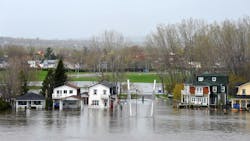Preparing for the Future with Flood-Resistant Building Design
Floods have had devastating effects worldwide, leaving many facility managers and building owners anxious to find feasible solutions for protecting their properties against these events. Many successful flood-resistant building efforts require applying creative thinking while addressing current and anticipated needs.
These tips are based on recent applications and can help property owners and managers protect against floods.
Leave Enough Room to Erect Modular Barriers
If your structure was built when flooding was not an immediate concern, it may require extra protection. Fortunately, some manufacturers have risen to the challenge by offering modular barriers. These barriers can be put up when flooding threats loom and taken down once the danger passes.
Companies like Wells Fargo and Citigroup, Inc. use them, as do people responsible for maintaining critical infrastructure. Besides the convenience and flexibility these products offer, people appreciate their reusability. Some brands can be used up to 60 times and stored flat between installations.
Although an integrated flood-resistant design is ideal for those who can feasibly implement it, ensuring the building has enough space around its perimeter for people to install modular barriers is another practical measure. Newer buildings designed with flood prevention in mind may only need strategically placed protection to safeguard areas that contain glass.
Work With the Surrounding Landscape
Many architects want to design buildings that blend into the surrounding landscape. In places where people do not want to overshadow natural beauty or risk negatively impacting an area’s historical significance, building new construction that lives in harmony with preexisting structures or environments is of particular concern. However, this priority can also work well as professionals evaluate specific flood-resistant designs.
Some human activities—such as excavation—can cause water and debris to flow through modified areas, even after modest rainfall. Floods may exacerbate those effects. People can make thoughtful design choices that protect buildings from these extreme events without making potentially detrimental impacts on the environment.
In Australia, architects designed the Bundanon Art Museum as two separate structures, each built to withstand a particular kind of natural disaster. Professionals built one structure into a hill to protect it from the bushfires that commonly affect the region. The flood-resistant building strategy for the second structure was to revisit a technique used during the Renaissance Era to help people make the best use of space. Since there is a flood-prone gully in the area, the team built a 520-foot habitable bridge over it, keeping the museum well above the water.
The design includes a corrugated metal roof canopy and open breezeways that let people admire the picturesque landscape. It also incorporates 32 residency rooms for artists, a creative learning space, a cafe and a dining area.
Incorporate Smart Sensors Into Flood-Resistant Design
Many time-tested design techniques—such as putting buildings on stilts so rising water cannot touch them—remain relevant today. However, as building owners and other concerned parties consider those traditional methods, they should also explore how to modernize their efforts.
Smart sensors have quickly gained popularity over a relatively short period. Sensors that can detect and automatically respond to issues could reduce negative impacts. Some commercial buildings already have technology that can detect leaks, providing people with efficient warning systems that can prevent costly repairs and insurance claims.
Facility managers may also wish to incorporate these sensors into existing visibility tools, such as platforms that allow them to monitor a building’s energy use or other details over time. Although sensors may not prevent flood damage, they can alert people to shortcomings in their existing protection measures. Then, parties may have enough information to react in time, reducing the potential impact of floods.
A project led by the University of Maryland’s Department of Atmospheric and Oceanic Science aims to improve preparedness for communities located along the Chesapeake Bay. Participants will focus on flood predictions by installing more than 20 sensors along the body of water and its tributaries. These solar-powered additions will help people living or working in the area become more aware of impending dangers. Residents already routinely place sandbags in front of their homes and buildings to prevent flooding, but predictive capabilities could also benefit them.
Remain Aware of Flood-Resistant Building Advancements
Flood resistance will remain a priority for everyone interested in protecting their properties. As someone who owns or manages buildings, you should keep informed of ongoing improvements in this area. As you hear about interesting engineering and design decisions, ask yourself whether they might become relevant to you.
About the Author
Ellie Gabel
Ellie Gabel is an associate editor for Revolutionized.
